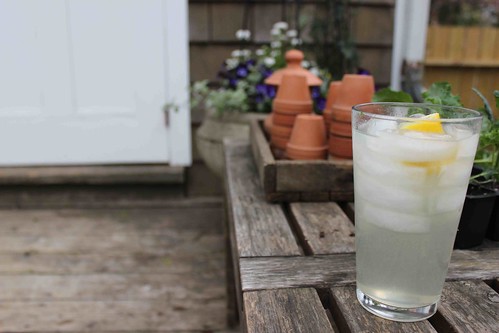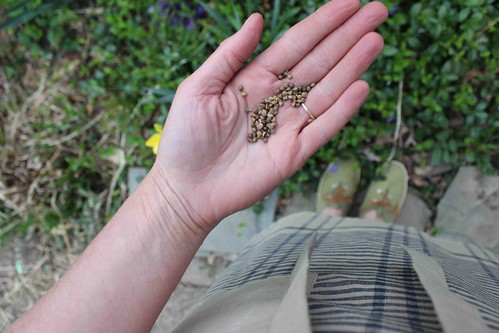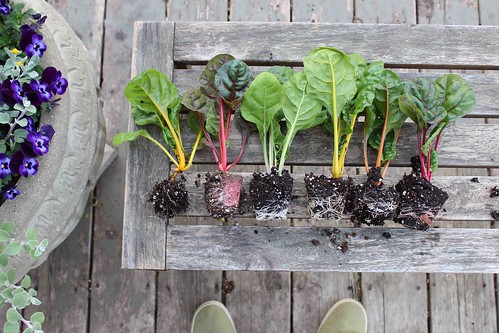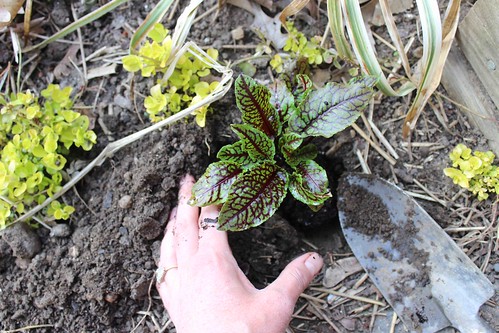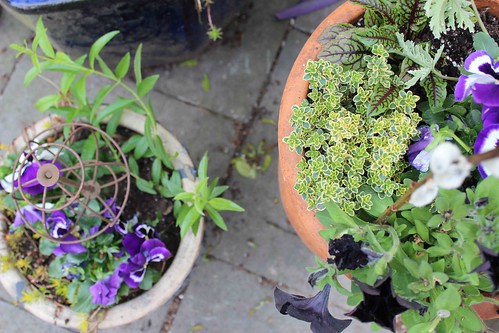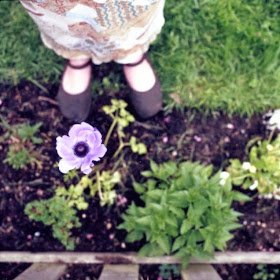Good morning! I am so tickled to be here with you and share a little about what's going on in my garden. Memphis has a really warm climate (we've recently been moved to zone 8a) and spring usually comes early for us- the end of February and first of March brings daffodils, hyacinths, and sees hellebores taking their exit. Even after our fierce winter (we usually see lows in the 20s and were stunned by some of our single-digit lows this year), spring has been lovely. The tulips and daffs are almost over, azaleas in full swing, and the dogwoods have another week or so before they say goodbye. Roses are budding up and my asparagus is sending out the first tender spears.

I have been doing a lot of prep work for the other major part of my garden this spring- I got a new beehive! I have had a top bar hive for two years. This is the top bar hive, to the right, in mid-summer.
Originally, I bought a nuc (a starter hive with a queen, workers, and eggs) and was sad to see it die of starvation in March of 2013. Mere weeks after I cleared the hive, some friends alerted me to a swarm of bees clinging to a weeping willow tree in their neighborhood. One morning my husband and I donned veils, grabbed some sugar water spray, a bee brush, and a modified banker's box and captured our
first swarm. The bees were happy and gentle and increased exponentially in numbers- so much so that I wondered how I'd work with them. One morning in May, I stepped outside the back door and saw
another swarm in the very top of my fig tree! I called my bee mentor and we retrieved it (with a lot of work) and it went to his bee farm.
A swarm is the bee colony's way of dividing- only very healthy colonies with a good laying queen will swarm- essentially, they outgrow their space. The queen lays eggs and when the worker bees realize that they're close to running out of room, they build a specially shaped cup, called a queen cup, in preparation for a swarm. There are usually several, queen cups. When the queen lays the egg into the cup, the workers feed the developing bee royal jelly to facilitate her growth from a regular worker bee into a queen. Once the cell is capped, the queen will leave with up to 60% of her colony, looking for a new home. A swarm is generally a gentle thing- all of the bees are clustered around the queen, keeping her warm (90 degrees is their optimal temperature), but sometime they land in inconvenient places, like the top of the fig tree!

After capturing two swarms in 2013, I wanted to avoid that this spring. I bought a langstroth hive from my bee mentor and we began the process of checking for queen cells, pulling frames of brood and eggs, and moving them into the new hive body. We moved the old hive to a new location, hoping to confuse the foraging bees so that they'd go to the new hive, and made sure to leave plenty of capped brood in the old hive so that the colony would continue to thrive. In this photo, we've pulled the frames from the top bar hive and are checking for brood (the baby bees and eggs). You can see that the comb is built off of wooden bars (and plastic supports, because sometimes in hot weather the comb has softened and fallen off of the bar- it is a big mess when that happens).

This is my new langstroth hive. The bottom two boxes hold the same sort of triangular-shaped pieces of comb from the top bar hive. The upper box holds smaller square frames that are full of foundation and drawn out comb. When I checked them last week, they were beginning to store honey in the upper box. The natural colored wood holds a large feeder. As the colony grows, I'll add more boxes for honey storage. I still need to paint them, too.
I felt very pleased with how the transition went and both hives seemed to be active. Just as I was congratulating myself on having avoided a swarm, I looked up into the antique rose bush outside my back door and saw this:
A swarm! Early on Monday morning I was ready to start my day in the studio when I noticed bees flying into the rose bush. It is not yet blooming, and the camellia that grows with it has finished up for the year, so I was perplexed until it dawned on me what had happened. I was going to have to capture a swarm anyway! Happily, these bees are not my bees but a swarm from either a neighboring hive or a feral colony. They are a different type- more yellow with more highly defined stripes than my two colonies. Again, I called my mentor, and he came to get them. This removal was easy, especially in comparison to the swarm in the top of my fig tree. Several days later, I looked up again and there's another swarm. Very same spot. Pheromones? Who knows.
At this point, I am preparing myself for another swarm and getting a bee box ready so that I can get them to someone else who can rehome them. Tis the season for bees.
If you should be so lucky to see a swarm of bees, don't panic! Look up your local beekeepers association and see if they have a list of beekeepers who will come to rescue the swarm (and you!).
Thanks for reading about my spring bee adventures. I'll see you here again next Tuesday with more news from my Memphis garden!





















